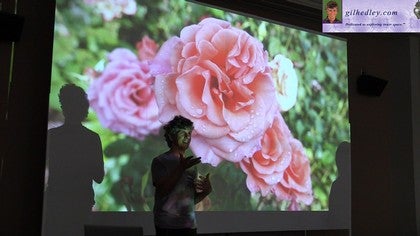Description
This video was filmed and produced by Gil Hedley. It includes videos and photos of dissections of cadavers (embalmed human donors). You can visit his website for more information about his workshops.
About This Video
Transcript
Read Full Transcript
[inaudible] no one else is talking. [inaudible] [inaudible] you don't talk and I do. You'll hear me. That's awesome. Paula Jasper. Thank you. [inaudible] Hoover.
Welcome to Gill [inaudible] therapeutic tonight or that was coming back. I was so excited. The last time I saw bill is 12 years ago before [inaudible] joined in with the naturopath doctors [inaudible] here. [inaudible] [inaudible] [inaudible] people that are interested in the human body. So when I first met gala dinner, because all of us, I have a couple codings that are here that we're all together, education, logical. Then he went on to tell me this amazing story that when he was a kid he used to like to collect, you'll kill and rape home.
Do you remember that? And you're like my mom, your mom's so cool. [inaudible] so cool. But I don't want to take too much time. I just wanted to welcome everybody here. I wanted to welcome well and I hope you guys [inaudible] [inaudible] [inaudible] deeply appreciative of your warm welcome. Thank you. This is maybe a memorial. I'm constantly finding ways to show my respect for the donor and gifts of which I'm the beneficiary. And for coming here today, I am trust in charge. You also there responsibility
Because your mind to learn from these forms, fulfilling your wishes, the donors and their families that these bodies be put to good use. I find this to be an extraordinary good use of fan queue. Um, and in that spirit I'll ask you, um, knowing that there's tons of good stuff online on my website, uh, that you could look at all day long. A, you'll refrain from any images of the stream. Um, I'm happy to take pictures with you over there. Uh, that having been said, there's going to be a lot of words slides, so I'm just gonna give that to you in a pdf. Okay. So not the write down all the words that I put up there. I don't, right? I am floating. I'm floating freely wait lists. I am fluid in fluid.
I am the Union of two and [inaudible] Paul and also something new. I am the one swirling in an ocean of pleasure. I have always been and I am always becoming. I'm extending myself into the thick of it. And dividing but not conquered.
I enjoy movement and have no brain. I stream and flow yet have no heart. I the whole, the very soul of my mother. Yet I have no eyes. I am the life coming into form, breathing and I'm born without knowing how or needing to know how. Breathing out I let go, I die. I yield to the tide and the next in rushing wave of life freely given I am an embodied, I've come to play, to learn, to expand, to love, to serve.
I've come to do so here and now in this place with these people, I am forming the habits of my mind. I am awake in my choices. I claim my power as a shaper of you mind, stuff to experience the whole through this one fluid form. Gotcha. The role with fashion and healthy movement, let me park on that for four hours. So I'm a little obsessed folks, a little obsessed several years now with a problem like a puzzle. The puzzle being I'm going to have one thing, do one sort of continuous thing on body from oneself.
How do you have such a thing? And simultaneously have differential movement, right? Nature solves this problem, but not with the tree, right? The tree sways it moves, it moves in the breeze. The bark doesn't slide on the trunk does it? It doesn't have differential moment. Oh girl, she could skip around the bottom of the trunk. She has a differential movement. This is a good trick if you really think about it, it's a pretty impressive trip. What's the anatomy of that?
What does that look like on the inside and how might knowledge of that help us in our, in our practices, in our service and our own embodiment, so total connection and differential movement. How, and I'll say nature is solutions, national system and fluids. This is not an exhaustive list so there should add to this pile. These are just, I'm just offering you what I've observed from my studies in the laboratory, not what I've observed from reading articles and books, which I kind of tail off on about 12 years ago when I embraced this particular text as the focus of my attention in a way that I can't, I don't, I don't check out other books. I just keep reading this one over and over again and it should, the textures I find here is a chapter of that text that I keep reading over and over again. Now, there might be other ways to solve these problems, but this is where my observations are coming from. Now, Fascia, simple word, Latin bandage. If you go into your bathroom and check the medical kit or in your glove compartment, you'll find that there are lots of different kinds of advantages. Well, lots of different kinds of fashion.
So by analogy also the Latin poets, when they saw that white gauze in the sky referenced it also as a fashion.
[inaudible] beautiful swarm us married, uh, her head there with a cow. I find this remarkable. Anyway, if you want to know where you've come from, go back in the same way. [inaudible] pathway. It's a sacred pathway, right? The entrance into the, the divine, the temple of the spirit, our bodies, the lab and our bodies. Both sacred places. So superficial Fascia, also known as Hypodermis, hypo under Dermis, terminus or subcutaneous adipose.
The fatty layer underneath your skin. Great. So I've got to call the whole fatty layer. Superficial Fascia. You'll find some, some European anatomists and traditions. We'll reference only the membranes within the fatty layer as the superficial fashion. I follow grace tradition. We can hold more of two ideas in our heads. Right?
And you can see it's both a lobular, it's a lobular. And also there's this, um, there's this weapon in there. There's structure, there's, there's a connective tissue matrix. Uh, that's, that's structuring the tissue and giving it its dimension. Um, we're just gonna list them for now. So number two is still me fashion feel me, fashion folks. This one is the fuss. Okay? First of all, it's like a reaction where I got into the lab the first time I started pulling stuff apart and I was like this fucking mountain. Okay. Two, after about 10 years, I started calling it fashion. Listen to my DVDs. You'll hear, I keep talking about the films, the films. Okay. So, uh, so filming fashion, the multiplayer membranous, uh, connective tissue. Now a real general anonymous, we'll call this loose area like connective tissue. Um, we would use the same phraseology for the superficial fashion. A loose arrow connective tissue.
I'm going to show you that this issues early on so it loose arms, so Ariel or I don't want to cut off for you in a way that demonstrates some as a fashion. This one would be, okay, so if the superficial fashion is the gauze in your medicat, the filming faction, right is going to be the same [inaudible] more, more, more a fan and flat. You see that the fiber organization here is not heavily piddling in dimension, but rather it's to as fin and felt that you know, felt the takes on wet wall and it goes [inaudible]. If you're like in a Waldorf school, you make a jacket for a known
[inaudible] finally, the deep fashion, this is the poster child with fashion. This is, this is the one that, this is the star. This is the one that researchers hang out with and jump up and down on. You can call a fashion dense regular fibers fashion. It's cool stuff. Maybe in the Medicare, uh, that would be say the mandate or maybe even strapping tape.
Now you see this strapping tape with it's this thick white lines organized in a row. This is a very clear, precise kind of organization, not stopped it, not like that. So well maybe the Fascia Lata have a good cure on the side. Top of the thigh, deep Fascia. Can you see the similarity? You see how s how one is straight and thicken and the white collage in and collagenous bandings are and how they're sequenced, you know, in a very orderly row. So that's what we call dense, regular fibrous fashion fashion for funders so that the fashion now around the body, all these tissues take on different characteristics that are not absolutely consistent in their presentation for one area body. So not so maybe no strings double up. Well maybe they triple up, maybe they triple up at right angles to each other.
I don't know. I'd be interesting. And we're looking at something like that. So this is the it man from the deep side. Three layers of collagenous fibers tightly organized in rows at 90 degree angles to each other, stacked to create this kind of a fabric. Quite sturdy here on an unfixed score, meaning preserved only by refrigeration. We see on the forearm also deep Fascia.
You see how the fibers are thinner, they're more loosely spaced and there's only two layers of them, right? So this is, you can play with that in your mind in different combinations. The same way you can take flour and sugar and eggs and milk and butter. I make a hundred different things. Similarly, you can take these kinds of patternings and curve balls with different types of too fast you'll find around your body. Of course, in Florida, I have squirrels in my palm trees and the children need pressure off of the trees and it rains down in my front yard and they make their nests out of it. Nature loves to repeat her patterns.
So by the textures, you shall love them. Folks, spongy, slippery, [inaudible], spongy, slippery, scrappy, hypodermis, superficial find with spongy one. If you were to just touch your forearm here, very gently, very light, eyeball pressure, barely touching, right, and just press in a little bit, it'll bounce back to your right. There's all little little spray in there. That's the fatty layer. That's the hypodermis, the superficial Fascia. But if you have attacking contact with the skin and go back and forth, right? You see there's a slippery layer there as well. That's deep.
That's deep to the fatty layer right now. Press. That's the filming fashion. Now, press through that and you'll feel the density of the muscle wrappings that are the deep fashion. All right? Can you feel those three different textures that are present in to your right here? Everywhere, all over the surface of your body and your neighbors. If you want to give us a queasy





You need to be a subscriber to post a comment.
Please Log In or Create an Account to start your free trial.